Collisions
Download as ppt, pdf2 likes565 views
This document discusses several examples that illustrate Newton's laws of motion, especially as they relate to car accidents and the importance of seatbelts. It provides crash test footage showing that without seatbelts, passengers continue moving at the speed of the car and collide with the interior, while seatbelts allow for gradual deceleration. Conservation of momentum is also demonstrated, such as when a firefighter holding a high-pressure water hose experiences significant recoil.
1 of 14
Downloaded 29 times
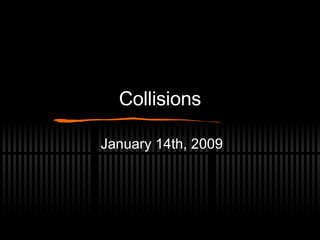
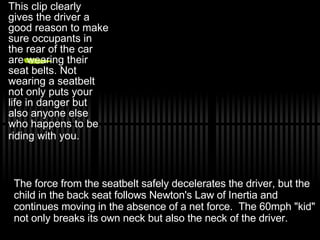



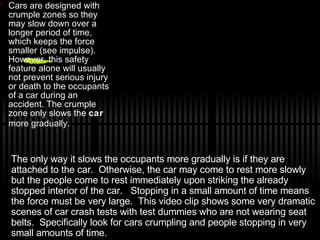
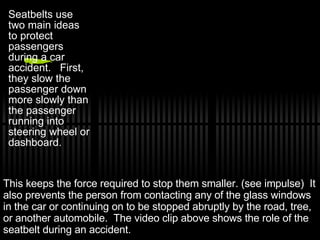
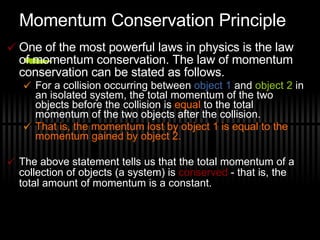

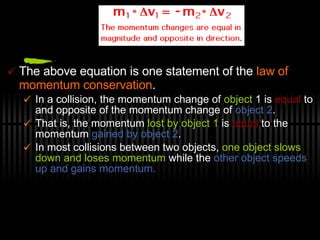
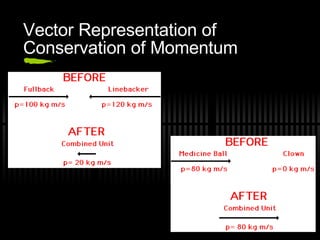
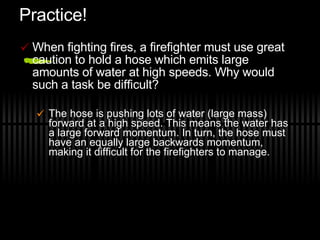
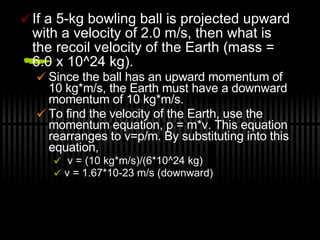

Ad
Recommended
2014 adb train trainers 1
2014 adb train trainers 1Global NCAP
?
The document summarizes key topics discussed at a vehicle safety workshop, including:
1. The origins of motor vehicle safety regulations dating back to 1909 with the first international convention establishing design standards.
2. How vehicle safety has improved over time through regulatory standards and consumer demand, but there is still work to be done in rapidly motorizing countries.
3. The UN Decade of Action's goal to reduce road fatalities by 50% by 2020 through initiatives like building safer vehicles, roads, and post-crash response systems.Creative journey
Creative journeyMitchell Frick
?
The document discusses impact attenuators for solar sports cars. It describes how impact attenuators absorb kinetic energy during collisions to distribute force evenly and reduce passenger deceleration. Effective attenuators are needed at speeds over 15 km/h to protect pedestrians and over 40 km/h to protect occupants. Design ideas discussed include honeycomb structures, explosives, and different materials like foam and aluminum. Testing attenuators is difficult as it destroys the design. The document considers positioning of attenuators to protect the passenger safety cell. It notes the design process is still deciding on materials while researching ideas and space constraints.Safety features in vehicles
Safety features in vehiclesSharandhass Radakrishnan
?
This document discusses safety features in vehicles that help prevent injuries during car crashes. It describes features like anti-lock braking systems, crumple zones, seat belts, airbags, side impact bars, windshields made of shatterproof glass, padded dashboards, and headrests. These features either help drivers maintain control of the vehicle during braking, absorb and distribute the force of impacts away from passengers, cushion passengers during collisions, or prevent specific injuries like neck injuries. The goal of these various safety features is to reduce the force of impacts and increase the time over which impacts occur to help protect passengers.Momentum e
Momentum eNatasia Gouws
?
If a net force acts on an object, it will accelerate in the direction of the force. The acceleration is directly proportional to the force and inversely proportional to the mass. An object at rest or moving at constant velocity will remain that way unless a net force acts on it. If object A exerts a force on object B, B will exert an equal and opposite force on A.Lecture 8
Lecture 8Chantel Davis
?
1) Newton's third law states that for every action, there is an equal and opposite reaction. Whenever one object exerts a force on a second object, the second object exerts an equal force back on the first.
2) Momentum is defined as the product of an object's mass and velocity. It represents the difficulty of stopping or changing the motion of an object. Objects with greater mass or velocity have greater momentum.
3) The change in an object's momentum is called impulse. Impulse depends on both the magnitude of the force applied and the duration of its application. A longer application of force results in a greater change in momentum.Crumple Zones: Impulse and Momentum
Crumple Zones: Impulse and MomentumJan Parker
?
1. The document provides instructions for a lab on crumple zones. Students will design and test crumple zones made of paper, tape, rubber bands and string to protect a block in a cart from tipping over during crashes.
2. The document discusses factors that must be considered when designing crumple zones like materials and how cushioning can be described scientifically as increasing stopping distance or time.
3. Formulas are provided that show as distance or time increase during impact, force decreases, helping to decrease the risk of injury in a collision.P2.2 car design & safety
P2.2 car design & safetySteve Bishop
?
The document discusses various car safety features and the physics behind how they work to reduce forces and injuries during collisions. It explains that seatbelts, airbags, crumple zones, and other features work to increase the time over which a person decelerates during a crash, which reduces the force on the body. Regenerative braking is also discussed as a way to capture some of the kinetic energy lost during braking.Momentum6 24 Spelling
Momentum6 24 SpellingJames Redmond
?
The document describes an experiment that tested different materials as simulated highway barriers to determine which material best increases the time of impact during a simulated car crash. The hypothesis was that a hollow, inelastic material would increase impact time the most. Data showed that an origami ball increased time more than control/styrofoam materials. The hypothesis was supported as the hollow, collapsible origami ball best increased impact time and reduced force.momentum
momentumNurul Ezzati Abu Hasan
?
The document discusses crumple zones in automobiles. Crumple zones are designed to absorb energy during a collision by crumpling instead of maintaining structural integrity. They help reduce injuries by lengthening the time of impact and decreasing acceleration forces on passengers. The experiment showed that adding more aluminum foil cylinders to simulate crumple zones increased stopping time and decreased maximum acceleration, with two cylinders performing best. Effective crumple zone materials include high density polymeric foam reinforced with fibers, surrounded by low density foam and mechanical ribs made of strong metals.Motorcycle Safety
Motorcycle SafetyRRChandran
?
A motorcycle provides freedom but lacks safety compared to a car. Riders should always wear certified helmets that are securely fastened to avoid head injuries in the event of an accident. Proper use of brakes and mirrors, as well as following road safety tips like wearing bright clothing and scanning ahead, can help riders anticipate hazards and be visible to others on the road. While agile, motorcycles do not protect riders like cars, so safety precautions are important.Presentazionebwin
PresentazionebwinSilvio De Rossi
?
La ricerca condotta dalla Harvard Medical School con bwin esamina i potenziali rischi del gioco online, suggerendo che non esistono evidenze scientifiche solide che provino che il gioco online sia pi©┤ rischioso di quello offline. Inoltre, il documento sottolinea che politiche privi di un quadro scientifico possono aggravare i problemi di dipendenza e che un approccio basato su evidenze scientifiche ©© fondamentale per garantire la sicurezza dei giocatori. Infine, la collaborazione con Harvard ha prodotto studi che dimostrano che il comportamento di gioco pu©░ essere monitorato in tempo reale per migliorare le pratiche di gioco responsabile.03 Dissertaciones Hist Ricas Del Orden Y CSuany Rosario
?
Este documento presenta un libro escaneado por Google como parte de un proyecto para digitalizar libros de dominio p©▓blico y hacerlos disponibles en l©¬nea. Explica que el libro es de dominio p©▓blico porque los derechos de autor han expirado, y proporciona pautas sobre el uso no comercial de los archivos digitales y la atribuci©«n requerida.«ökeynoteė÷ęŖipod Touch
«ökeynoteė÷ęŖipod Touchė└Õa Åł
?
The document appears to be notes from a presentation comparing the Keynote, iPod Touch, and iPhone. It lists the products and contains repeated questions of "why" and "then" suggesting points being made about the products, followed by how's and but's that may outline challenges or limitations. The document ends with a note about a pointer or remote.Writing A Lab Report- Komperda
Writing A Lab Report- KomperdaRegis Komperda
?
This document outlines the key parts and structure of a lab report, including the title, purpose, pre-lab questions, materials, procedures, data, and conclusions. It notes that the title should concisely describe the experiment, the purpose explains what was hoped to be learned, and the procedures section details the steps taken and any differences from the printed instructions or safety measures used. It also provides guidance on formatting the data table and writing the conclusions section to analyze what was learned and identify sources of error.Sos gioco
Sos giocoSilvio De Rossi
?
Il servizio sosgioco offre supporto a chi affronta problemi legati al gioco d'azzardo, tramite una rete di psicologi e psicoterapeuti specializzati. Forniscono valutazioni, consulenze su opzioni di trattamento e supporto per i familiari. Nei primi sei mesi, il servizio ha registrato 12.000 visitatori sul sito, 970 chiamate e 92 consulenze effettuate.Examples pp documentation
Examples pp documentationlindahauck
?
This document provides guidelines for properly attributing and documenting sources in PowerPoint presentations. It recommends attributing the creator and source on each slide. The attribution should include the name of any databases, websites, or root URLs used to find the source. It also advises listing the date the source was retrieved and providing a credits slide at the end to attribute any content not easily cited on individual slides. Consistency in documentation style is emphasized.Nomenclature Part 3
Nomenclature Part 3Regis Komperda
?
This document discusses naming and writing formulas for polyatomic and binary covalent compounds. It provides the following rules:
1) For polyatomic ionic compounds, identify and name the cation and anion, then combine the names with the cation first followed by the anion.
2) For binary covalent compounds composed of two non-metals, the first element is named first using its full name, and the second element name uses the suffix "-ide".
3) Prefixes are used to indicate the number of atoms present, with "mono-" only used for the second element. Examples of common prefixes are given.
4) To write formulas from names, identify the cation and anion,║▌║▌▀Ż quiz #1
║▌║▌▀Ż quiz #1stewartl
?
This document provides an overview of important artists and works from the Early Renaissance, High Renaissance, Northern Renaissance, and Baroque periods. It lists the names of multiple influential 15th-16th century Italian artists such as Brunelleschi, Ghiberti, Donatello, Masaccio, Botticelli, and da Vinci. It also highlights works by Michelangelo, Raphael, Bosch, Bruegel, Durer, Bernini and Caravaggio from the 14th to 17th centuries. The document serves as a survey of major developments and influential figures across Renaissance and Baroque art history.Rethink Christmas Slowdown
Rethink Christmas SlowdownNLBC
?
The document discusses the need to slow down and eliminate hurry from life. It notes that business information is doubling every few years, requiring people to do more in less time. Several quotes encourage rest and finding balance, including Jesus saying his yoke is easy and burden light. The story of Mary and Martha is discussed, with Jesus saying Mary discovered the one thing worth being concerned about.Gioco censis servizi
Gioco censis serviziSilvio De Rossi
?
Il documento analizza dieci anni di crescita e innovazione nel mercato dei giochi in Italia, evidenziando l'evoluzione dell'offerta tra giochi di fortuna e abilit©ż dal 1999 al 2011. Viene presentata una panoramica dei consumi e del gioco pro-capite in diverse province italiane, con particolare attenzione al profilo dei ludopatici. Infine, si discute la riduzione dell'illegalit©ż nel settore e le implicazioni sociali del gioco.ąęĖŻąąČ»╝ęš▄╚┘Ų▀ĘųńŖ
ąęĖŻąąČ»╝ęš▄╚┘Ų▀ĘųńŖė└Õa Åł
?
▒Š╬─╠Į╠ų┴╦─¦╩§Ą─š▄č¦║═ųŪ╗█Ż¼Ū┐Ą„╚╦├ŪĄ─Ėąų¬ėļŽų╩ĄĄ─▓ŅŠÓŻ¼▓óŪęųĖ│÷─¦╩§į┌Ė„┴ņė“Ą─ė”ė├ĪŻ═©╣²─¦╩§Ą─└²ūėŻ¼ū„š▀Įę╩Š┴╦╚╦╔·Ą─Ė┤įėąį║═ČįŽŻ═¹Ą─┐╩═¹ĪŻūŅųšŻ¼Ū┐Ą„└ĒĮŌūį╬ę║═šõŽ¦╔·╗Ņųą▒õ╗»Ą─ųžę¬ąįĪŻPresentation eeep comiclab
Presentation eeep comiclabGiorgos Papanikolaou
?
7th meeting eeep dtpe
7. Sitzung eeep dtpe
7”Ž ”ę”į”═?”─”č”╔”Ž ”ź”ź”ź”░ ”ż”│”░”źHomer donut odyssey
Homer donut odysseymjacobson
?
The document outlines the process for how a bill becomes a law in Congress. It goes through several steps including being introduced in the House or Senate, referred to a committee, debated, possibly amended, voted on, and if passed sent to the other chamber to repeat the process before being sent to the President to be signed into law. If vetoed by the President, Congress can still pass it into law with a two-thirds majority vote in both houses.powerpoint presentation on Vehicle crash Analysis
powerpoint presentation on Vehicle crash AnalysisRajeshM436962
?
The document discusses the impact of technological advancements on vehicle safety, focusing on the physics of car crashes, including the forces involved, types of collisions, and causes of accidents. Key concepts highlighted include mass, speed, momentum, and the importance of safety features such as seatbelts and airbags. It also emphasizes the necessity of proper safety measures and awareness while traveling in vehicles.More Related Content
Viewers also liked (20)
momentum
momentumNurul Ezzati Abu Hasan
?
The document discusses crumple zones in automobiles. Crumple zones are designed to absorb energy during a collision by crumpling instead of maintaining structural integrity. They help reduce injuries by lengthening the time of impact and decreasing acceleration forces on passengers. The experiment showed that adding more aluminum foil cylinders to simulate crumple zones increased stopping time and decreased maximum acceleration, with two cylinders performing best. Effective crumple zone materials include high density polymeric foam reinforced with fibers, surrounded by low density foam and mechanical ribs made of strong metals.Motorcycle Safety
Motorcycle SafetyRRChandran
?
A motorcycle provides freedom but lacks safety compared to a car. Riders should always wear certified helmets that are securely fastened to avoid head injuries in the event of an accident. Proper use of brakes and mirrors, as well as following road safety tips like wearing bright clothing and scanning ahead, can help riders anticipate hazards and be visible to others on the road. While agile, motorcycles do not protect riders like cars, so safety precautions are important.Presentazionebwin
PresentazionebwinSilvio De Rossi
?
La ricerca condotta dalla Harvard Medical School con bwin esamina i potenziali rischi del gioco online, suggerendo che non esistono evidenze scientifiche solide che provino che il gioco online sia pi©┤ rischioso di quello offline. Inoltre, il documento sottolinea che politiche privi di un quadro scientifico possono aggravare i problemi di dipendenza e che un approccio basato su evidenze scientifiche ©© fondamentale per garantire la sicurezza dei giocatori. Infine, la collaborazione con Harvard ha prodotto studi che dimostrano che il comportamento di gioco pu©░ essere monitorato in tempo reale per migliorare le pratiche di gioco responsabile.03 Dissertaciones Hist Ricas Del Orden Y CSuany Rosario
?
Este documento presenta un libro escaneado por Google como parte de un proyecto para digitalizar libros de dominio p©▓blico y hacerlos disponibles en l©¬nea. Explica que el libro es de dominio p©▓blico porque los derechos de autor han expirado, y proporciona pautas sobre el uso no comercial de los archivos digitales y la atribuci©«n requerida.«ökeynoteė÷ęŖipod Touch
«ökeynoteė÷ęŖipod Touchė└Õa Åł
?
The document appears to be notes from a presentation comparing the Keynote, iPod Touch, and iPhone. It lists the products and contains repeated questions of "why" and "then" suggesting points being made about the products, followed by how's and but's that may outline challenges or limitations. The document ends with a note about a pointer or remote.Writing A Lab Report- Komperda
Writing A Lab Report- KomperdaRegis Komperda
?
This document outlines the key parts and structure of a lab report, including the title, purpose, pre-lab questions, materials, procedures, data, and conclusions. It notes that the title should concisely describe the experiment, the purpose explains what was hoped to be learned, and the procedures section details the steps taken and any differences from the printed instructions or safety measures used. It also provides guidance on formatting the data table and writing the conclusions section to analyze what was learned and identify sources of error.Sos gioco
Sos giocoSilvio De Rossi
?
Il servizio sosgioco offre supporto a chi affronta problemi legati al gioco d'azzardo, tramite una rete di psicologi e psicoterapeuti specializzati. Forniscono valutazioni, consulenze su opzioni di trattamento e supporto per i familiari. Nei primi sei mesi, il servizio ha registrato 12.000 visitatori sul sito, 970 chiamate e 92 consulenze effettuate.Examples pp documentation
Examples pp documentationlindahauck
?
This document provides guidelines for properly attributing and documenting sources in PowerPoint presentations. It recommends attributing the creator and source on each slide. The attribution should include the name of any databases, websites, or root URLs used to find the source. It also advises listing the date the source was retrieved and providing a credits slide at the end to attribute any content not easily cited on individual slides. Consistency in documentation style is emphasized.Nomenclature Part 3
Nomenclature Part 3Regis Komperda
?
This document discusses naming and writing formulas for polyatomic and binary covalent compounds. It provides the following rules:
1) For polyatomic ionic compounds, identify and name the cation and anion, then combine the names with the cation first followed by the anion.
2) For binary covalent compounds composed of two non-metals, the first element is named first using its full name, and the second element name uses the suffix "-ide".
3) Prefixes are used to indicate the number of atoms present, with "mono-" only used for the second element. Examples of common prefixes are given.
4) To write formulas from names, identify the cation and anion,║▌║▌▀Ż quiz #1
║▌║▌▀Ż quiz #1stewartl
?
This document provides an overview of important artists and works from the Early Renaissance, High Renaissance, Northern Renaissance, and Baroque periods. It lists the names of multiple influential 15th-16th century Italian artists such as Brunelleschi, Ghiberti, Donatello, Masaccio, Botticelli, and da Vinci. It also highlights works by Michelangelo, Raphael, Bosch, Bruegel, Durer, Bernini and Caravaggio from the 14th to 17th centuries. The document serves as a survey of major developments and influential figures across Renaissance and Baroque art history.Rethink Christmas Slowdown
Rethink Christmas SlowdownNLBC
?
The document discusses the need to slow down and eliminate hurry from life. It notes that business information is doubling every few years, requiring people to do more in less time. Several quotes encourage rest and finding balance, including Jesus saying his yoke is easy and burden light. The story of Mary and Martha is discussed, with Jesus saying Mary discovered the one thing worth being concerned about.Gioco censis servizi
Gioco censis serviziSilvio De Rossi
?
Il documento analizza dieci anni di crescita e innovazione nel mercato dei giochi in Italia, evidenziando l'evoluzione dell'offerta tra giochi di fortuna e abilit©ż dal 1999 al 2011. Viene presentata una panoramica dei consumi e del gioco pro-capite in diverse province italiane, con particolare attenzione al profilo dei ludopatici. Infine, si discute la riduzione dell'illegalit©ż nel settore e le implicazioni sociali del gioco.ąęĖŻąąČ»╝ęš▄╚┘Ų▀ĘųńŖ
ąęĖŻąąČ»╝ęš▄╚┘Ų▀ĘųńŖė└Õa Åł
?
▒Š╬─╠Į╠ų┴╦─¦╩§Ą─š▄č¦║═ųŪ╗█Ż¼Ū┐Ą„╚╦├ŪĄ─Ėąų¬ėļŽų╩ĄĄ─▓ŅŠÓŻ¼▓óŪęųĖ│÷─¦╩§į┌Ė„┴ņė“Ą─ė”ė├ĪŻ═©╣²─¦╩§Ą─└²ūėŻ¼ū„š▀Įę╩Š┴╦╚╦╔·Ą─Ė┤įėąį║═ČįŽŻ═¹Ą─┐╩═¹ĪŻūŅųšŻ¼Ū┐Ą„└ĒĮŌūį╬ę║═šõŽ¦╔·╗Ņųą▒õ╗»Ą─ųžę¬ąįĪŻPresentation eeep comiclab
Presentation eeep comiclabGiorgos Papanikolaou
?
7th meeting eeep dtpe
7. Sitzung eeep dtpe
7”Ž ”ę”į”═?”─”č”╔”Ž ”ź”ź”ź”░ ”ż”│”░”źHomer donut odyssey
Homer donut odysseymjacobson
?
The document outlines the process for how a bill becomes a law in Congress. It goes through several steps including being introduced in the House or Senate, referred to a committee, debated, possibly amended, voted on, and if passed sent to the other chamber to repeat the process before being sent to the President to be signed into law. If vetoed by the President, Congress can still pass it into law with a two-thirds majority vote in both houses.Similar to Collisions (20)
powerpoint presentation on Vehicle crash Analysis
powerpoint presentation on Vehicle crash AnalysisRajeshM436962
?
The document discusses the impact of technological advancements on vehicle safety, focusing on the physics of car crashes, including the forces involved, types of collisions, and causes of accidents. Key concepts highlighted include mass, speed, momentum, and the importance of safety features such as seatbelts and airbags. It also emphasizes the necessity of proper safety measures and awareness while traveling in vehicles.Conservation Of Momentum
Conservation Of Momentumeliseb
?
The document discusses collisions and the law of conservation of momentum. It provides examples of how to use a momentum table and algebra to solve for unknown velocities in collision problems involving isolated systems where momentum is conserved. Specifically, it works through examples of a person catching a medicine ball on ice and of two people colliding on an ice rink to determine their combined velocity after collision.Pressure and Forces
Pressure and ForcesJan Parker
?
1. The document outlines an upcoming class that will include testing accident statistics knowledge, performing a lab on seat belts, taking notes, and working problems.
2. The lab on seat belts will involve designing a safe seat belt for a race car, reading about Newton's First Law of Motion, and investigating how different types of seat belts transfer force.
3. Key points from the lab include that in any car accident there are three collisions, pressure is what determines injury from a seat belt rather than force alone, and the pressure formula relates force and area.Pressure and Forces
Pressure and ForcesJan Parker
?
The document outlines the agenda for a class that will include testing student's knowledge of accident statistics through a quiz, performing a lab on seat belts, taking notes on Newton's laws of motion and the three collisions that occur in car accidents, and working practice problems. Students are instructed to get materials and begin the accident statistics quiz before the tardy bell rings.11 momentum
11 momentumIZZUDIN IBRAHIM
?
1. Momentum is defined as the product of an object's mass and velocity. It is a conserved quantity such that the total momentum of an isolated system remains constant.
2. During collisions, conservation of momentum states that the total momentum of colliding objects before the collision equals the total momentum after. If no external forces are applied, momentum is conserved.
3. Collisions can be elastic, where both momentum and kinetic energy are conserved, or inelastic where kinetic energy is not conserved but momentum still is. The analysis of collisions uses conservation laws to solve for unknown velocities.Class 9th- Force & Laws of Motion pdf to study.
Class 9th- Force & Laws of Motion pdf to study.zaidmulla354w
?
Study these notes of force and laws of motion and get excellent marks in exam. It is very important to read notes. You can download it and take the print of this. You can also read it through pc or tab.
Thanks for visiting this slide and follow for more such slides.Class 9th- chapter Force & Laws of Motion .pdf
Class 9th- chapter Force & Laws of Motion .pdfgauravgoswami78
?
The document discusses the concepts of force, motion, and Newton's laws, defining key terms like balanced and unbalanced forces, inertia, and momentum. It elaborates on Galileo's challenges to AristotleĪ»s views on motion and provides examples illustrating each of Newton's three laws of motion. Additionally, it addresses practical applications and implications of these principles in everyday scenarios.P5d Momentum
P5d MomentumM F Ebden
?
The document discusses momentum, forces, and collisions. It explains that for every action there is an equal and opposite reaction. It also explains the principles of momentum conservation and how total momentum is always conserved during collisions and explosions. Safety features in cars like seatbelts, airbags, and crumple zones help reduce injury by slowing down collisions and extending the time over which a change in momentum occurs.Math Physics Presentation
Math Physics Presentationguest7458a4
?
The document discusses traffic safety and compares crime and traffic crash statistics. It aims to educate young adults on traffic safety by dispelling myths and informing them about physics principles like Newton's laws of motion. Statistics show that far more people are killed in traffic crashes each year than by crimes like murder. For example, in 2005 there were 43,443 traffic deaths nationwide compared to 16,692 murders. The presentation emphasizes the dangers of speeding, following too closely, and not wearing a seatbelt based on mathematical calculations of braking distances and crash forces.Chapter 2: Forces and Motion
Chapter 2: Forces and Motion marjerin
?
The document defines inertia as an object's tendency to remain at rest or in motion. It discusses how inertia is related to an object's mass, with larger masses having greater inertia. It provides examples of how inertia causes objects to maintain their state of motion or rest in various situations, like coins dropping in glasses or passengers moving during sudden stops. Methods to reduce the negative effects of inertia, like safety belts and airbags, are also mentioned.Chapter 2: Forces and motion
Chapter 2: Forces and motion marjerin
?
The document defines inertia as an object's tendency to remain at rest or in motion. It discusses how inertia is related to an object's mass, with larger masses having greater inertia. It provides examples of how inertia causes objects to remain in motion, like liquids in stopped containers or passengers in braking cars. Methods to reduce the negative effects of inertia are mentioned, like seatbelts and airbags. The document also covers momentum, its relationship to mass and velocity, and the principle of conservation of momentum in elastic and inelastic collisions.Newton's laws of Motion: First, Second & Third
Newton's laws of Motion: First, Second & ThirdSizwe
?
The document outlines Newton's three laws of motion: the first law pertains to inertia, stating that an object remains in its state of motion unless acted upon by a force; the second law describes the relationship between force, mass, and acceleration, expressed as F=ma; and the third law states that for every action, there is an equal and opposite reaction. Real-world applications of these laws, such as the function of seatbelts in cars, demonstrate their relevance in everyday scenarios. The document also poses questions for consideration regarding motion, forces, and acceleration.MOmentum eta discurso plonigonial en la selva cauc©ósica
MOmentum eta discurso plonigonial en la selva cauc©ósicaUrda Urdae
?
This document explains the concept of momentum, defined as the product of mass and velocity, and how it relates to impulse and changes in motion. It discusses the law of conservation of momentum, particularly during collisions, and highlights practical applications of these concepts in real-life scenarios. Additionally, it covers how the time of a collision affects the force experienced by an object, as well as the importance of rebounding in impacts.Momentum (mass in Motion) in Physics, Science
Momentum (mass in Motion) in Physics, ScienceKarnchanaSathupun1
?
The document discusses the concepts of momentum and impulse, defining momentum as the product of mass and velocity, and illustrating its application in real-world scenarios such as sports and driving. It explains the relationship between force, time, and momentum change through Newton's laws, highlighting the conservation of momentum in collisions and the implications of collision time on force experienced by objects. Additionally, it describes practical applications, including techniques to minimize collision forces and the effects of rebounding in collisions.Momentum webversion.pptx
Momentum webversion.pptxRanaUmair74
?
Momentum is defined as the product of an object's mass and velocity. It is a vector quantity that depends on both the magnitude and direction of motion. During collisions or whenever a force acts upon an object, momentum changes occur. The impulse-momentum theorem states that the impulse on an object, which is the force applied over time, equals the change in momentum. Distributing the force of an impact over a longer period of time through compliant materials like sludge or crumpled car roofs can reduce the peak force and prevent serious injury. In interactions between objects, the total momentum is conserved according to the law of conservation of momentum.Force and laws of motion
Force and laws of motion BHAVAN VIDYALAYA, PANCHKULA
?
This document discusses the concept of force. It defines force as an external effort that can move an object at rest, stop a moving object, change the speed or direction of a moving object, or change the shape or size of an object. It then discusses Newton's three laws of motion - an object at rest stays at rest unless acted on by an unbalanced force, acceleration is produced by an unbalanced force and is directly proportional to the force and inversely proportional to the mass, and for every action there is an equal and opposite reaction. It also covers momentum, conservation of momentum, and provides examples to demonstrate these concepts.Physics - Chapter 6 - Momentum and Collisions
Physics - Chapter 6 - Momentum and CollisionsJPoilek
?
This document provides an overview of linear momentum and impulse. It defines momentum as the product of an object's mass and velocity (p=mv) and describes how momentum is a vector quantity. Impulse is defined as the change in momentum over time due to an external force (Impulse=Force x Time). The document explains how momentum is conserved in collisions and how the impulse-momentum theorem can be used to analyze collisions. It also distinguishes between perfectly elastic, perfectly inelastic, and inelastic collisions in terms of the objects' motions and changes to their kinetic energy before and after the collision.Momentum
MomentumEvans Rikhotso
?
The 3 conservation laws are:
1) Conservation of energy - the total energy of an isolated system remains constant over time.
2) Conservation of linear momentum - the total momentum of a system remains constant, as long as no external force acts on the system.
3) Conservation of angular momentum - the angular momentum of a system remains constant, as long as no external torque acts on it.Ad
More from Regis Komperda (20)
Ionic Nomenclature & Compounds
Ionic Nomenclature & CompoundsRegis Komperda
?
Ionic compounds are named by writing the cation first followed by the anion. Transition metals that can form multiple cations use Roman numerals in parentheses in the name to indicate the charge on the cation. The Roman numeral is not included in the chemical formula. Ionic compounds form crystalline structures where the cations and anions are packed tightly together.Covalent Nomenclature
Covalent NomenclatureRegis Komperda
?
This document outlines the rules for naming binary covalent compounds composed of two non-metal elements. The first element is named first using its full name, and the second element name has the suffix -ide added after dropping the ending. Prefixes are used to indicate the number of atoms present of the second element, with mono- only used for the second element and not the first. Example prefixes and their corresponding numbers are also provided, as well as examples of names for several binary covalent compounds.Periodic Trends
Periodic TrendsRegis Komperda
?
This document discusses polyatomic ions and how to name and write formulas for compounds containing them. Polyatomic ions are ions made of more than one element that stay together as a unit in chemical reactions. To write formulas, identify the cation and anion present and determine the necessary subscripts to make the total charge neutral. Example formulas given are sodium phosphate (Na3PO4) and magnesium phosphate (Mg3(PO4)2) to illustrate this process.Covalent Nomenclature
Covalent NomenclatureRegis Komperda
?
This document contains the chemical formulas or names of various substances that could be used in a chemistry bingo game. There are over 30 different chemicals listed, ranging from common salts and oxides to more complex compounds involving metals, nonmetals, and transition metals. The variety of substances mentioned provide many options for calling out formulas and properties as part of a bingo game focused on chemical compounds.Polyatomic Nomenclature
Polyatomic NomenclatureRegis Komperda
?
The document discusses the metric system and scientific notation. It provides details on:
- The metric system is based on units of meters, liters, and grams with prefixes like kilo and centi to denote multiples or fractions of the base units.
- Scientific notation expresses very large or small numbers as a number between 1 and 10 with an exponent of 10. This makes concise expressions like 2.898 x 108 for 289,800,000.
- Conversions within the metric system move the decimal point left or right based on moving to a larger or smaller unit, following powers of 10 denoted by the prefixes.Polyatomic Nomenclature
Polyatomic NomenclatureRegis Komperda
?
The document discusses the metric system and scientific notation. It provides details on:
- The metric system is based on units of meters, liters, and grams with prefixes like kilo and centi to denote multiples or fractions of the base units.
- Scientific notation expresses very large or small numbers as a number between 1 and 10 with an exponent of 10. This makes concise expressions like 2.898 x 108 for 289,800,000.
- Conversions within the metric system move the decimal point left or right based on moving to a larger or smaller unit, following powers of 10.Periodic Table E Config
Periodic Table E ConfigRegis Komperda
?
The document discusses the organization and structure of the periodic table. It explains that the periodic table is arranged by increasing atomic number and that new rows are added as elements exhibit repeating properties in each column. It then discusses various models that were developed to explain the organization and placement of electrons in atoms, including the Bohr model, quantum mechanical model, electron orbitals, and electron configurations.Nuclear Decay
Nuclear DecayRegis Komperda
?
The document discusses various types of nuclear decay:
- Alpha decay involves emitting an alpha particle (helium nucleus), decreasing the atomic number by 2 and mass number by 4.
- Beta decay involves changing a neutron to a proton and emitting an electron, increasing the atomic number by 1 while keeping the same mass number.
- Electron capture involves capturing an electron by a proton to form a neutron, decreasing the atomic number by 1 while keeping the same mass number.
- Positron emission involves changing a proton to a neutron and emitting a positron, decreasing the atomic number by 1 while keeping the same mass number.
- Gamma decay involves emitting a high-energy gamma ray without changing mass or atomic numberSemester 1 Review Jeopardy
Semester 1 Review JeopardyRegis Komperda
?
This document contains a chemistry jeopardy game covering topics from 5 units:
1) Measurement and calculations
2) States of matter and properties
3) Atomic structure
4) Radioactivity
5) Periodic trends
The questions cover concepts such as significant figures, conversions, physical and chemical properties, atomic structure, radioactive decay, electron configurations, and trends in atomic radius and ionization energy across the periodic table.Bingo
BingoRegis Komperda
?
This document contains the chemical formulas or names of various substances that could be used in a chemistry bingo game. There are over 30 different chemicals listed, ranging from common salts and oxides to more complex compounds containing transition metals, nonmetals, and organic molecules. The variety of substances mentioned provide many options for calling out squares in a bingo game focused on chemical formulas and names.Metric System Scientific Notation
Metric System Scientific NotationRegis Komperda
?
The document discusses the metric system and scientific notation. It provides details on:
- The metric system is based on units of meters, liters, and grams with prefixes like kilo and centi to denote multiples or fractions of the base units.
- Scientific notation expresses very large or small numbers as a number between 1 and 10 with an exponent of 10. This makes concise expressions like 2.898 x 108 for 289,800,000.
- Conversions within the metric system move the decimal point left or right based on moving to a larger or smaller unit, following powers of 10.Periodic Trends
Periodic TrendsRegis Komperda
?
1) Periodic trends refer to how properties of elements change regularly when arranged in order of increasing atomic number. These properties include atomic radius, ionization energy, and electronegativity.
2) Atomic radius generally increases moving left to right and decreases moving up a group. Ionization energy follows the opposite trend, increasing up and right as atomic radius decreases. Electronegativity also increases up and right.
3) The trends are due to changes in the number of protons, electrons, and shielding of core electrons that affect the attraction between electrons and the nucleus across the periodic table.Periodic Table E Config
Periodic Table E ConfigRegis Komperda
?
The document discusses the organization and structure of the periodic table. It explains that the periodic table is arranged by increasing atomic number and that new rows are added to accommodate elements with repeating properties in each column. It also discusses the patterns in the periodic table including groups/families defined by their number of outer shell electrons and typical ion charges.Periodic Table E Config
Periodic Table E ConfigRegis Komperda
?
The document discusses the organization and structure of the periodic table. It explains that the periodic table is arranged by increasing atomic number and that new rows are added as elements exhibit repeating properties in each column. It then discusses various models that describe the structure of atoms, including the Bohr model, quantum mechanical model, electron shells, orbitals, and electron configurations.Semester 1 Review Jeopardy
Semester 1 Review JeopardyRegis Komperda
?
This document contains a chemistry jeopardy game covering topics from 5 units:
1. Measurements and calculations
2. States of matter and properties
3. Atomic structure
4. Radioactivity
5. Periodic trends
The questions test knowledge of concepts like significant figures, conversions, physical and chemical properties, atomic structure, radioactive decay, electron configurations, and trends in atomic radius and ionization energy across the periodic table.Metric System Scientific Notation
Metric System Scientific NotationRegis Komperda
?
The document discusses the metric system and scientific notation. It provides the following key points:
1) The metric system is based on units of meters, liters, and grams, with prefixes like kilo and centi to denote multiples or fractions of the base units.
2) Conversions within the metric system involve moving the decimal point a consistent number of places to the right or left based on the prefix in use.
3) Scientific notation expresses very large or small numbers in a standardized form of a number between 1 and 10, multiplied by a power of 10. Conversions between scientific and standard notation involve moving the decimal accordingly.Metric System Scientific Notation
Metric System Scientific NotationRegis Komperda
?
The document discusses the metric system and scientific notation. It provides the following key points:
1) The metric system is based on units of meters, liters, and grams, with prefixes like kilo and centi to denote multiples or fractions of the base units.
2) Conversions within the metric system involve moving the decimal point a consistent number of places to the right or left based on the prefix in use.
3) Scientific notation expresses very large or small numbers in a standardized form of a number between 1 and 10, multiplied by a power of 10. Conversions between scientific and standard notation involve moving the decimal accordingly.Nuclear Decay
Nuclear DecayRegis Komperda
?
The document discusses various types of nuclear decay:
- Alpha decay involves emitting an alpha particle (helium nucleus), decreasing the atomic number by 2 and mass number by 4.
- Beta decay involves changing a neutron to a proton and emitting an electron, increasing the atomic number by 1 while keeping the same mass number.
- Electron capture involves capturing an electron by a proton to form a neutron, decreasing the atomic number by 1 while keeping the same mass number.
- Positron emission involves changing a proton to a neutron and emitting a positron, decreasing the atomic number by 1 while keeping the same mass number.
- Gamma decay involves emitting high energy gamma rays without changing mass or atomic number.Periodic Trends
Periodic TrendsRegis Komperda
?
1) Periodic trends refer to how properties of elements change regularly when arranged in order of increasing atomic number. These properties include atomic radius, ionization energy, and electronegativity.
2) Atomic radius generally increases moving left to right and decreases moving up a group. Ionization energy follows the opposite trend, increasing up and right as atomic radius decreases. Electronegativity also increases up and right.
3) The trends are due to changes in the number of protons, electrons, and shielding of core electrons that affect the attraction between electrons and the nucleus across the periodic table.Periodic Table E Config
Periodic Table E ConfigRegis Komperda
?
The document discusses the organization and structure of the periodic table. It explains that the periodic table is arranged by increasing atomic number and that new rows are added to accommodate elements with repeating properties in each column. It then discusses various models that describe the structure of atoms, including the Bohr model, quantum mechanical model, electron shells, orbitals, and electron configurations.Ad
Collisions
- 1. Collisions January 14th, 2009
- 2. This clip clearly gives the driver a good reason to make sure occupants in the rear of the car are wearing their seat belts. Not wearing a seatbelt not only puts your life in danger but also anyone else who happens to be riding with you. The force from the seatbelt safely decelerates the driver, but the child in the back seat follows Newton's Law of Inertia and continues moving in the absence of a net force. The 60mph "kid" not only breaks its own neck but also the neck of the driver.
- 3. This clip illustrates what happens to children in a car accident if they or their car seat are not properly belted in. (This particular car seat was flawed.) Remember, if the car was going 55mph, then any person or object in the car is also going that fast and will continue to go that fast until a net force acts on them to slow them down. It should be pointed out that the rotating dial makes 1 rotation in 1/10th of a second. It was used to measure small intervals of time on the film (pre-digital clock)
- 4. In this clip we see a "parent" holding a "child" and neither of them wearing a seatbelt. As you can see, the "parent" not only allows harm to come to the "child" but actually hurts the child more as the child becomes an ineffective "air bag" for the parent.
- 5. In this clip, we see that seat belts and child seats not only protect you in a frontal impact, they could also prevent a tragedy in rear end collision. They were at rest originally, and in the absence of a net force (from the seat belt) they remained at rest while the car they were in was accelerated by the net force from the car that hit them. Newton's first law can be a killer! In this clip, the station wagon literally gets accelerated out from under the "kids" sitting in the back.
- 6. Cars are designed with crumple zones so they may slow down over a longer period of time, which keeps the force smaller (see impulse). However, this safety feature alone will usually not prevent serious injury or death to the occupants of a car during an accident. The crumple zone only slows the car more gradually. The only way it slows the occupants more gradually is if they are attached to the car. Otherwise, the car may come to rest more slowly but the people come to rest immediately upon striking the already stopped interior of the car. Stopping in a small amount of time means the force must be very large. This video clip shows some very dramatic scenes of car crash tests with test dummies who are not wearing seat belts. Specifically look for cars crumpling and people stopping in very small amounts of time.
- 7. Seatbelts use two main ideas to protect passengers during a car accident. First, they slow the passenger down more slowly than the passenger running into steering wheel or dashboard. This keeps the force required to stop them smaller. (see impulse) It also prevents the person from contacting any of the glass windows in the car or continuing on to be stopped abruptly by the road, tree, or another automobile. The video clip above shows the role of the seatbelt during an accident.
- 8. Momentum Conservation Principle One of the most powerful laws in physics is the law of momentum conservation. The law of momentum conservation can be stated as follows. For a collision occurring between object 1 and object 2 in an isolated system, the total momentum of the two objects before the collision is equal to the total momentum of the two objects after the collision. That is, the momentum lost by object 1 is equal to the momentum gained by object 2. The above statement tells us that the total momentum of a collection of objects (a system) is conserved - that is, the total amount of momentum is a constant.
- 9. Consider a collision between two objects - object 1 and object 2. For such a collision, the forces acting between the two objects are equal in magnitude and opposite in direction (Newton's third law). This statement can be expressed in equation form as follows. The forces act between the two objects for a set time. Since they are colliding, this time must be the same! If force and time are the same, impulse must be the same! If impulse is the same, change in momentum must be the same
- 10. The above equation is one statement of the law of momentum conservation . In a collision, the momentum change of object 1 is equal to and opposite of the momentum change of object 2 . That is, the momentum lost by object 1 is equal to the momentum gained by object 2 . In most collisions between two objects, one object slows down and loses momentum while the other object speeds up and gains momentum.
- 11. Vector Representation of Conservation of Momentum
- 12. Practice! When fighting fires, a firefighter must use great caution to hold a hose which emits large amounts of water at high speeds. Why would such a task be difficult? The hose is pushing lots of water (large mass) forward at a high speed. This means the water has a large forward momentum. In turn, the hose must have an equally large backwards momentum, making it difficult for the firefighters to manage.
- 13. If a 5-kg bowling ball is projected upward with a velocity of 2.0 m/s, then what is the recoil velocity of the Earth (mass = 6.0 x 10^24 kg). Since the ball has an upward momentum of 10 kg*m/s, the Earth must have a downward momentum of 10 kg*m/s. To find the velocity of the Earth, use the momentum equation, p = m*v. This equation rearranges to v=p/m. By substituting into this equation, v = (10 kg*m/s)/(6*10^24 kg) v = 1.67*10-23 m/s (downward)
- 14. ?
